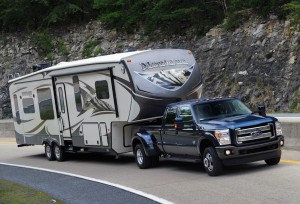With its new full-size F-Series pickups set to migrate to an “aluminum-intensive” design for 2015, Ford Motor Co. officials have confirmed that the maker’s heavy-duty models also will switch to the lightweight metal when they are redesigned several years from now.
The standard-duty full-size trucks will drop as much as 750 pounds in mass, Ford previously revealed, a move that should yield a significant boost in fuel economy. In turn, “Lightweighting offers a once-in-a-lifetime chance to conquest” buyers away from competitors such as General Motors and Chrysler, said Jim Farley, global sales and marketing director, during a presentation to industry analysts on Monday.
Ford is just preparing to roll out the new F-150, a move observers believe could be one of the most important it will make for years to come. That’s because the entire F-Series line-up – including standard and heavy-duty models – makes up the single best-selling product range in the U.S. auto industry.
There have been concerns about potential problems with the debut of the aluminum-bodied trucks, but Ford continues to insist the launch is on track for later this year. The plan is to start with just the mainstream F-150 line-up, and production has already shifted to the new model at the Ford truck plant near the company’s suburban Detroit headquarters.
Ford officials wouldn’t disclose specific details on the Super Duty program, though those heavy-duty models also are expected to adopt aluminum body architectures that could yield substantial reductions in weight – and concurrent improvements in fuel economy.
(Ford posts $1.3 billion profit in 2Q. For more, Click Here.)
Mileage has become an increasingly important issue to truck buyers, but automakers like Ford also need to improve fuel efficiency simply to meet the tough new government mandates that will fall into place over the next decade.
(Click Here for details on how far Ford shares plunged on tough news.)
The Super Duty models comprise about a third of all Ford F-Series sales – and generate disproportionately high profits.
(To see more about Chrysler doubling diesel-powered Ram production, Click Here.)
Earlier this year, automotive “spy” photographers captured images of an early Super Duty prototype catching fire and burning to the ground during hot weather testing in the Mojave Desert. Ford has not issued an explanation for the mishap.
The maker isn’t the first to adopt aluminum; Jaguar and Land Rover have both used the lightweight metal extensively in recent years. But Ford is the first to take it mainstream. And many industry analysts believe that if the F-Series program proves successful, competitors like GM and Chrysler – as well as Asian truck makers Toyota and Nissan – will eventually have to shift to aluminum, as well.


It has been known for decades in the auto industry that aluminum and composites are viable in many areas of construction. The problem has always been and will continue to be costs.
With Obama and the EPA forcing care makers to try to reach impossible 54.5 mpg CAFE requirements the auto/truck makers have little choice but to use these lighter weight but far more expensive materials – at a cost to consumers estimated to be anywhere from $3,000-$15,000 per car. Truck prices may be even higher depending on where the lighter materials can effectively be used.
Crash repair of these vehicles is also going to be staggering meaning insurance companies are very likely to not only increase rates dramatically, they will “total” vehicles much more frequently than repairing them meaning customers will be raped twice.
It’s the details that Obama and the EPA don’t bother to tell the populace that continue to drive the U.S. standard of living down for the majority while the criminals in DC live high on the hog paid for by tax payers.